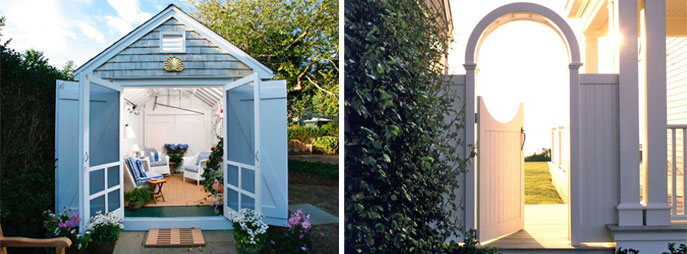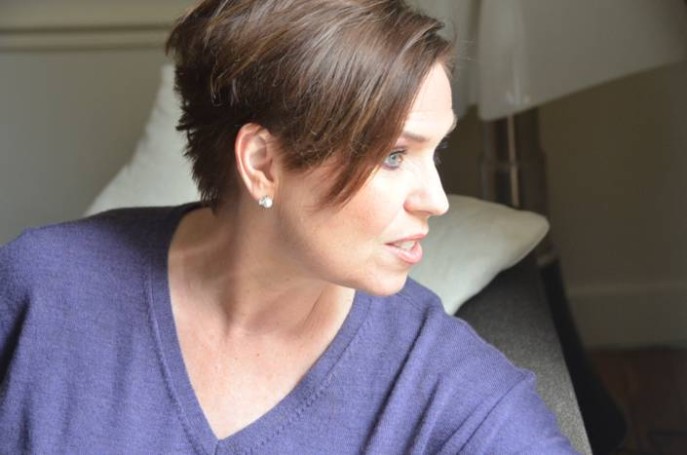
This is part two of my interview with Debbie Phillips for Women on Fire, the group she founded to bring an amazing circle of fabulous women together for inspiration, strategies and support. The following is a transcript of part two of our talk on Your Sacred Space: How to Create an Inspired, Healthy Living Environment. Read Part One here.
continued…
Trudy: What I’m striving for is indoor air quality–whatever we put in that space. And the only space you can really control is your own environment, your home, so that everything in there supports your health and wellbeing.
Debbie: Right. Well, I love that notion, and I’m sure that people listening are thinking, “Well, how can I control other environments?” But like you said, we can control our homes. We can also control our cars, and some of us can control our offices. Is there any way, Trudy, to control other environments–short of wearing a mask?
Trudy: I think a lot of it is education, and you know I’m big on that. I’m always trying to promote how to support yourself at home through my blog and also in the lectures I do on The Holistic House. People ask, “Where should I begin?” Begin in the nursery because your baby is sleeping in there 20-24 hours a day and breathing in that air. But your own bedroom needs to be almost like a bell jar–really clean and free of dust and dust mites. Don’t have a lot of wall-to-wall carpeting because there is so much that gets trapped underneath there.
Debbie: Really?
Trudy: Oh, yes, microbial growth. At least area rugs can be sent out and steam cleaned.
Debbie: Interesting. So choose hardwood floors and rugs over wall-to-wall carpet.
Trudy: Hardwood floors, tile floors, stone floors–those are the cleanest. They are the easiest to keep clean and dust-free. When people who are really allergic or who have asthmatic children come to me, I tell them to damp mop their floors–as if we have enough free time to do all this. But try to damp mop floors twice a week. It is believed that our livers detox somewhere between 2:00 and 4:00 a.m. Your liver and your kidneys are really hard at work, so you want to sleep in a really clean environment so you’re not still taxing your system and your organs.
Debbie: Trudy, I’ve seen those air filters that often can be bought at specialty stores. is there any kind or a particular air filter that you would recommend?
Trudy: As you know, I had such a struggle with chemical sensitivity. I had to go through a two-year detox program, which was almost like being on chemotherapy. It was really rough. So I don’t want to see other people go through that. The one filter that the environmental physicians–there are only 400 in the whole world; it is a very specialized group–like is the Austin HealthMate Plus. And the reason for that, Deb, is that it has a HEPA filter in there to filter out particulates–dust, mold spores, animal dander, pollen in the spring. But it also has zeolite in the carbon filtration, which filters out vapors such as car fumes. If you have a garage that’s part of your house, car fumes can infiltrate and go right through all the little perforations into the house. The Austin HealthMate Plus filters out all of that. It will filter out and lower the VOCs from your furniture because all furniture finishes have VOCs. So that’s the filter I swear by.
Debbie: That’s great. Is there a particular kind of mattress or pillow or bedding? I know it should be from organic cotton, but is there any particular brand or style that you think is best?
Trudy: There are so many out there, so I want to tell everybody: Buyer beware. Make sure you really go to someone who can say that a mattress is truly organic cotton or it’s truly organic wool because it has been certified. I personally like a wool mattress that’s been tufted, and then I have it encased in organic cotton. I get my physician to write me a prescription slip, so to speak, to give to the people making the mattresses, saying that i refuse to have it sprayed with fire retardant. By law, they have to add fire retardant in case there is a smoker in bed and a cigarette is dropped. But it’s a problem because the rest of us have to pay the price by sleeping on a bed immersed in that chemical, and you really don’t want that.
Debbie: Wow.
Trudy: The other thing you want to do–because dust mites and the little things they leave behind are what a lot of people are allergic to, especially asthmatic children–is to get an encasement, a completely zip-around mattress protector. It’s not just a pad on the top, and it’s made out of barrier cloth. That keeps out dust mites, bed bugs, all those things that can happen, and you are much safer. Your pillow really shouldn’t be foam or anything made of a chemical. it should be organic cotton or organic wool, again, in an organic-cotton encasement protector.
Debbie: Is there anything around the waterproofing of a mattress pad? Would that necessarily have chemicals in it?
Trudy: It could. Until I look at the label, I wouldn’t know. You have to be careful of chemicals, especially where you are sleeping at night. That’s the one room to change. People say, “I can’t afford to go through and change my whole house.” And I completely relate to that. But try to make your bedroom as clean, organic and chemical-free as possible. That’s the goal.
Debbie: This is so helpful because one of the things Rob and I have done is to create a couple’s sanctuary, but we have not gone to this level. This is very inspiring. I want to talk about something else that would potentially be a tip, Trudy, and that is because we are talking about an inspired environment with a strong emphasis on creating a healthy environment. I want to tell you a quick little story. When I met Rob, who is now my husband, he had this rule that one way to create a sacred environment was that all shoes were to be removed before entering the house. it took me a little while to get used to that, but I have adopted his ways and I have to say that I love it. And, Trudy, you are the only other person I’ve met who has a porch full of shoes. I wondered if that’s a rule at your house–a shoeless house–and is there a good reason for not wearing shoes in the house?
Trudy: Absolutely. I think it’s sacred. It’s respectful to remove your shoes, to not bring in all that stuff from the street. Asians do that a lot. But there is also a very scientific reason for it: When we are walking around on the street, we are actually walking through viruses, bacteria, chemicals sprayed on the streets to melt ice, and all of that. We walk through that, and we definitely don’t want to track it into the house. People I’ve studied with have said that if you could make pesticides iridescent and if you used a black light on them, they would glow. And if you had somebody walk through his yard after it was sprayed for ticks or mosquitoes or whatever and then you tracked him as he walked through the house, there would be footprints everywhere he went in the house. So that’s your practical reason. Let’s not bring all this inside. My biggest pet peeve is pesticides, chemicals, insecticides, mildewcides, and all of that. I understand the purpose of it and I know what people are trying to do, but I think the public doesn’t always know the horrible side effects of it.
Debbie: Right. It’s funny, but I wonder if you have had this experience: both of our homes on Martha’s Vineyard and Naples are shoeless, but I still feel a little embarrassed asking people to remove their shoes.
Trudy: You know what I do?
Debbie: What do you do?
Trudy: I go to Rite Aid and buy the little cotton socklets in all sizes, and I leave them right there at the door because sometimes people don’t want to slip on slippers if they feel that somebody else’s feet have been in there. I relate to that.
Debbie: I do too.
Trudy: So get a fresh, sealed bag of little socklets, and you can get the ones that the men don’t mind wearing. They’re almost like the little things they give you in the hospital when you’re walking up and down the halls. And that just covers it when they’re in your home, and they can choose their colors. Then it becomes sort of fun.
Debbie: What a great idea. Thank you, Trudy. That solves that problem. What are some other ways to detox our homes or space? And, by the way, I hear a lot about that. People will talk about, “I’m going to clear or detox my space.” Is there an appropriate way to clear and detox a home?
Trudy: The biggest thing is what you put in it. Let’s say you’re painting. There was some wonderful person who sent me an email this morning, “How do you choose your paint?” I wasn’t sure if she was asking about color or if she wanted to know how to choose a safe paint. For the latter, the biggest thing you can do, if you know you have oil-based paint and you’r’e going to repaint, is to go to a low-or no-VOC–again, Volatile Organic Compound–water-based latex paint. Oil paint is a petroleum product. People say, “Oh, my house doesn’t smell anymore. I painted it three months ago.” If you could dye those VOCs purple, you would see that they go on forever. It’s truly deleterious to your health. It’s truly injurious. It’s not good for your lungs. It’s just not good for a lot of reasons.
Debbie: Do the major paint companies make those or do you have to find a special company?
Trudy: They do. And so you don’t have to spend a fortune for that. If you don’t have a chemical sensitivity, you probably don’t have to go as far as I do with it for my own health.
Debbie: You were referring to a question from Jill Dulitsky, from Vernon, Connecticut. She asked, ‘We are redoing our house and making a much more open floor plan. How do you choose paint?”
Trudy: I emailed her back so we will continue that discussion, for sure.
Debbie: I don’t know whether she did mean color. Melissa McClain from Seattle, Washington, is very into color, and we should just bring up the color issue since I’m not sure what Jill meant. Melissa asks, “What is your philosophy on finding the perfect color for your home or room?”
Trudy: It’s really client-driven. After I sit and talk with clients, I get a feel for what they like. I also give them a client questionnaire. It’s long. I ask them, “What are your favorite colors? What colors do you hate?” I tell them to get five of the current shelter magazines and tear out pages and write on them, saying, “Trudy, I love this. I hate that.” By the time we’ve spoken and they’ve filled that out and I look at their tear sheets, I have a good sense of what they would thrive in. There has been a lot of research done on people who have thyroid issues, which I do. They thrive with the color blue. Well, it’s no surprise that I have a lot of blue in my houses. That’s my house in Connecticut. Debbie would love it. It’s more taupe and white and the sandy colors. And say people with stomach issues really resonate to the color orange. So, basically, what I do is interview everybody and I find out what they love. Sometimes they don’t even really know what they’re gravitating to, but I can see it. I can see it formulating. Then we get a little report back to them, and we sit down and start with color swatches. Then I see what they respond to.
Debbie: I love it.
Trudy: They always reach out with their hand for the things they love.
Debbie: Really?
Trudy: Oh, yes. If they don’t like anything, the hand doesn’t come forward. When they see a color they love, the hand goes out and they start rubbing it. I say, “Oh, that’s it! That’s the one. That one likes Sea Glass. She likes that color.”
Debbie: This is why you are the genius you are. That is really great to know. I know you love blue. All those blues are so beautiful on your site. What color don’t you like?
Trudy: You know, it used to be orange, but I’m in love with that color now. When I was going to art school, I took a course at Yale. It was a color study course. It forced us to become neutral about color. Most people don’t know this–I think you might, Deb–but I was a fine arts major, and I was a painter first.
Debbie: I did know that.
Trudy: I approach color in a whole different way. I had a studio in Rowayton, Connecticut, on the water. I’m always by the water, whether it’s a river, a lake, Long Island Sound, Nantucket Sound, whatever. I did commission paintings, and I loved it. I taught art for a while in Rowayton, and I taught at New Canaan High School. I loved working with the high-school students. I just loved that. But it was too solitary for me when I was working in the studio. I’d come home at night and I’d think, “I didn’t talk to anybody all day.” So I found myself gravitating toward doing rooms, and I thought, “OK, now I have to get more information about this.” So I went back to school at Parsons in New York. I also did a lot of on-the-job training. I had some wonderful mentors and teachers. You can shift course midstream.
Debbie: Yes, you can.
Trudy: It’s OK to do a mid-course correction.
Debbie: Well, as I always say, we’re stomping our perimeter. We’re building on what our interests are. Like the fact that you were two years old and you were sketching, and then you just continued to build on that to be the person you are and create the amazing environments that you do now.
Trudy: You know, Deb, I really thought when I was younger that I was just going to grow up and be an artist. I didn’t know I was going to go into interior design. It just evolved. It was an evolutionary process.
Debbie: Melissa McClain also asked the question, “Was there a defining moment where you knew you wanted to be a designer?”
Trudy: Yes. It was in that studio. I said, “You know what? I want to work with people. I want to make rooms that they feel good in. I want to work with fabric.” I just jumped in and started. I didn’t have enough training yet, so I went back and got the training that I felt I needed. But the best training I had, Deb, was on the job, watching other designers that I really admired.
Debbie: Oh, I’m sure. Trudy, believe it or not, our chats just go so quickly. In the ten minutes or so that we have left, I want to give our women some other tips for creating an inspired environment. Are there other things, in addition to the advice that if you start with any place start with your bedroom? Did we answer the question about what’s he right way to go about detoxing a room?
Trudy: There are different ways to detox a room. From a spiritual level, I like using sage. When I first had a house in Monomoy on the water on Nantucket, I knew a wonderful woman who was a minister. I had her come over, and she brought some other people. We said prayers to the north, the east, the south and the west. We asked blessings from every direction, and that was a truly blessed house. Wonderful. That’s one way to detox–mentally, spiritually and emotionally. The other detox method concerns the materials you are using. Say you bought a piece of furniture from a place where they use a lot of particleboards in the middle, and the formaldehyde levels are off the wall. You can even smell it. It has that kind of stinky smell. I would get that piece of furniture right out of the room immediately. I would stick it down in the basement until it offgasses enough. That’s one way to detox.
Now the truth is that formaldehyde probably never offgasses enough that it’s truly safe. But to detox a room, you have to minimize whatever is toxic in it. So if it’s the furniture, that’s one thing that goes. If it’s an old chemical-sprayed rug, one that you’ve used a lot of retardants for stain and stuff on, you just have to get rid of that. It’s time to roll it up. What people forget is that, even with area rugs, the pad underneath is disintegrating over time. We have a friend in New York who is being treated for leukemia. He had a stem cell transplant, and they’re calling me for a lot of advice on how to detox the home. The big thing they talked about was that they had all of the Oriental rugs taken to be steam cleaned. No chemicals, just steam cleaned. But it was the pads underneath that needed to be changed. There was too much microbial growth.
Debbie: Interesting.
Trudy: Get a new pad for under your rug. There are a lot of simple things you can do. You can put a coat of nontoxic paint on the walls.
Debbie: You’re inspiring me. There are some really simple things like that I need to do. I think we’ve had the pads under our rugs for ten years.
Trudy: There’s always time for a change! We vacuum the rugs all the time and even have them shampooed from the surface. But it’s best to roll them up and send them out to be steam cleaned. And we never check that pad. I’m guilty too.
Debbie: Hey, Trudy, I always hear about mold and how that is really dangerous in a home. Is there anything we can do about mold?
Trudy: The minute you have heat and moisture and darkness, you have a breeding ground for mold. Mold needs all three. You don’t see mold growing in bright sunlight. You don’t see mold growing where there is no moisture, and you don’t see it growing where there is no heat. So, if it’s freezing outside, you don’t see mold growing on the rocks or anything. Mold and pesticides–those two are my pet peeves. It is deleterious to your health. They affect respiratory systems. Stachybotrys atra is one. There were some fatalities in Long Island of infants who were in basement rooms that had been paneled, and there was stachybotrys atra growing on the sheetrock behind the paneling.
Debbie: How do you test for mold?
Trudy: You can get kits. You can order them online. You put these little plates out, and then you collect them and send them off to a lab. They will tell you if you have it or not. You can also use a Certified Industrial Hygienist (CIH). They are wonderful. These guys are like doctors. They are just amazing. They have so much information, and they can come and check for you. It’s truly like having people with doctoral degrees in all these chemicals and the molds. They are very valuable. I have one I use all the time: Microecologies in New York. I’ve known them for about 15 to 20 years, and I have a lot of trust and faith in them. I don’t know if you’ve noticed it, Deb, but when I walk into a moldy house, it smells sweet to me. Have you ever noticed that? I can smell the mold or the mildew.
Debbie: Well, you’re such a pro, Trudy.
Trudy: I don’t know if it’s being a pro or that I have such heightened smells from being chemically sensitive. That’s one of the downfalls of being chemically sensitive.
Debbie: And I’m just so glad that you’ve been able to recover. One of the reasons is because you live in this holistic house.
Trudy: Deb, there’s one last thing I wanted to say. We’re probably getting close to the end.
Debbie: We are.
Trudy: I was so torn between just talking about how to make your home pretty and beautiful and talking about it being green and healthy. Then I realized that I want the two to go together, hand in hand. And that’s why I talk about “eco-elegant.” I want the two to not be separate, but to be all one.
We focused on the “green” now, because let’s start with everybody’s health. Their environment, their built-in environment, their home, or just their bedroom, if they can do only one room in the home, is truly supporting. It’s their underpinning.
Debbie: Yes.
Trudy: It’s got their back, so to speak, and their heart, as (Woman on Fire) Agapi Stassinopoulos (author of Unbinding the Heart) would say.
Debbie: That is a very beautiful way to put that. And, you know, Trudy, you are such a part of Women on Fire, and I’m grateful for Women on Fire to have access to your wonderful work. I could go on and on. I’m grateful to have a woman like you.
Trudy: Thank you. I am so honored to be a part of this interview.

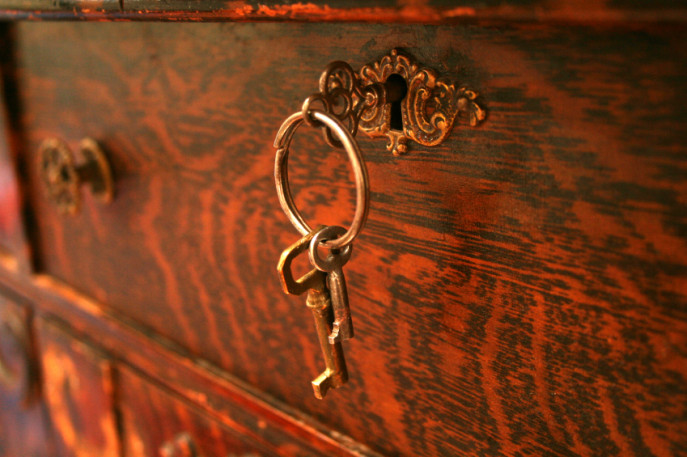

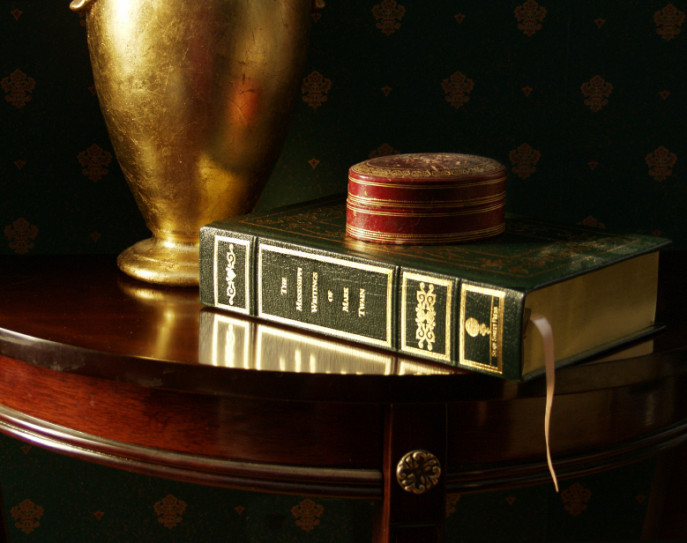
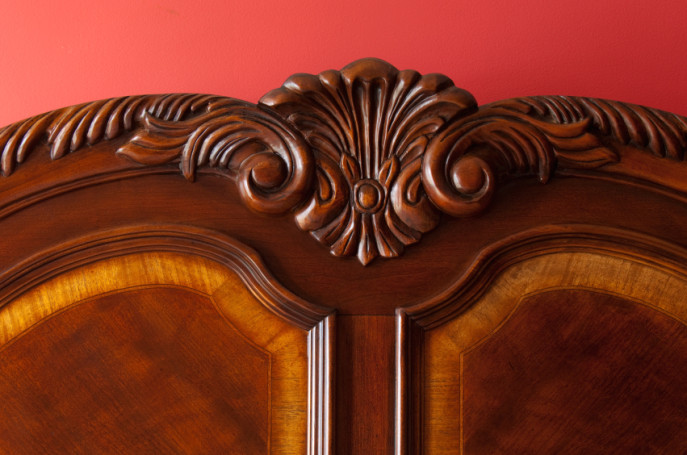
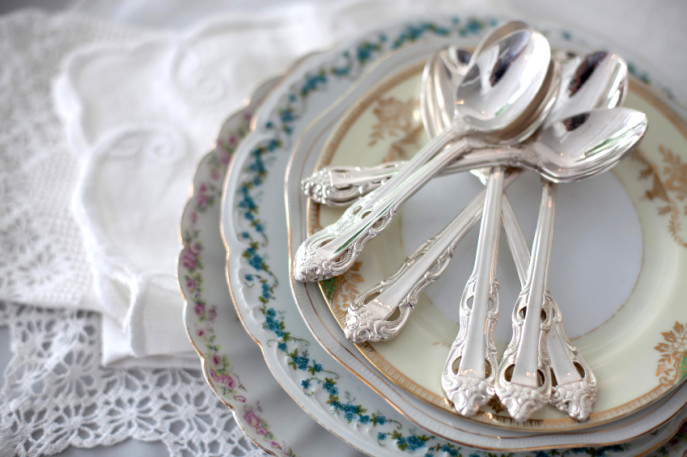
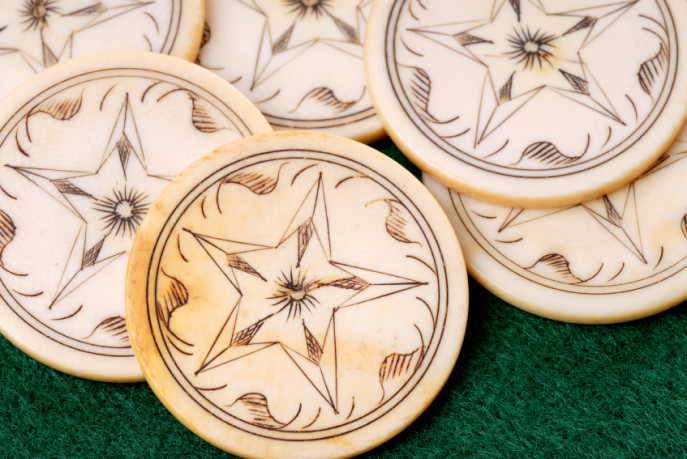









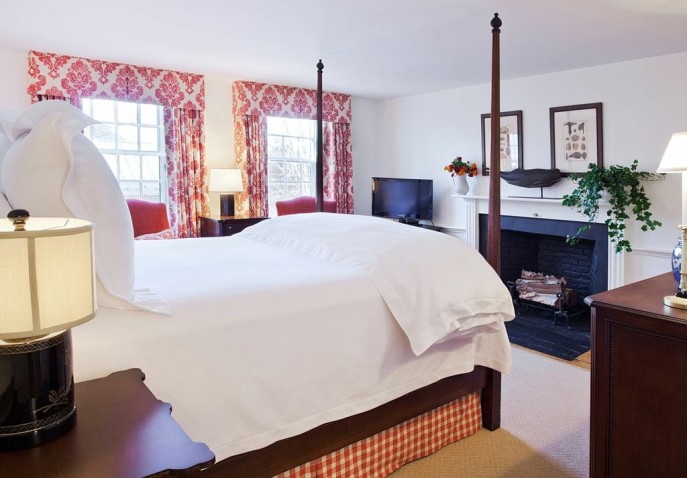
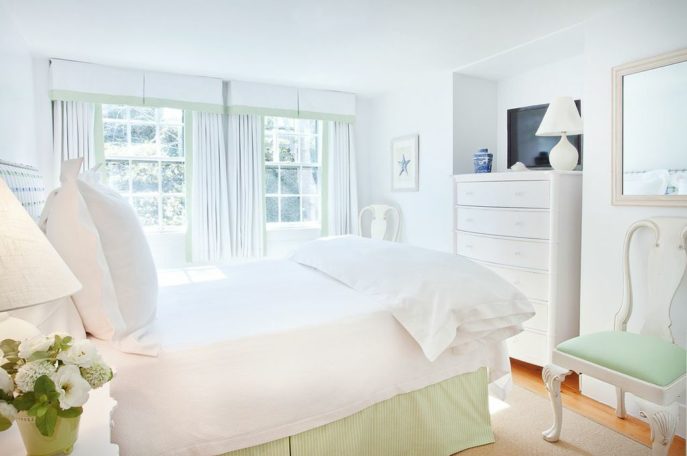
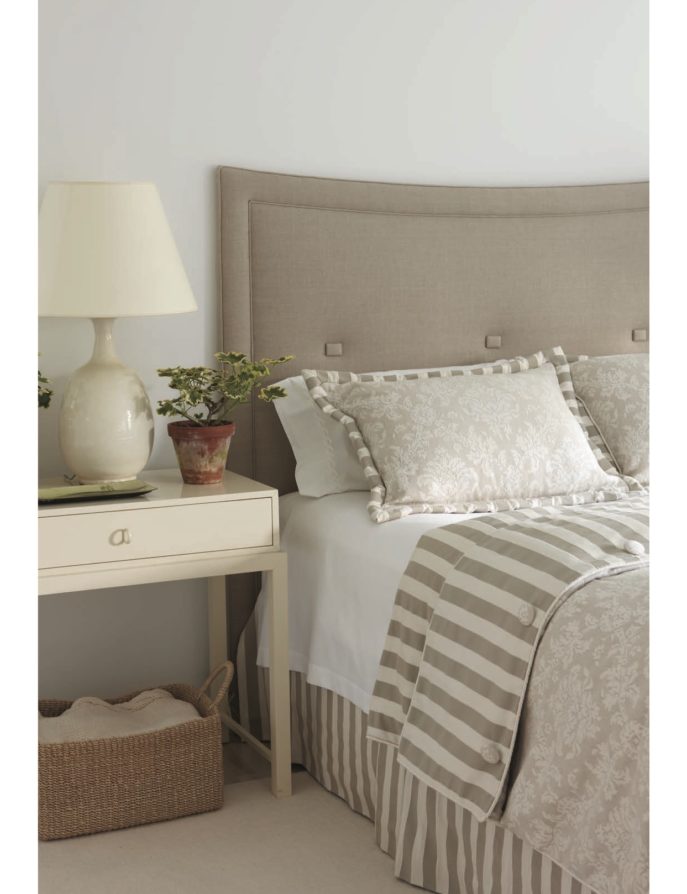
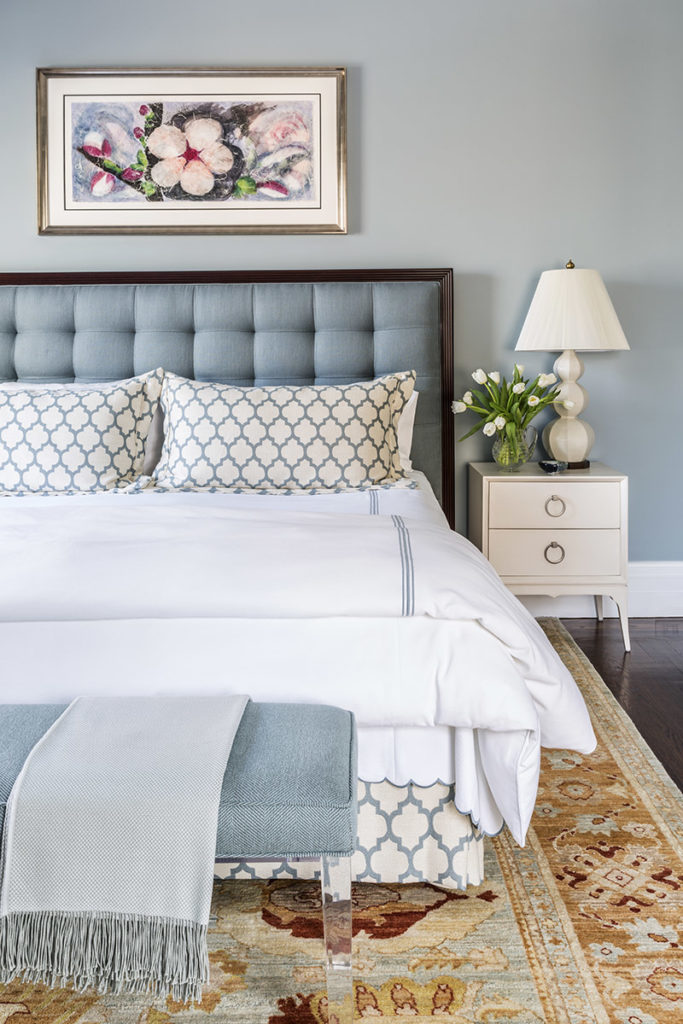
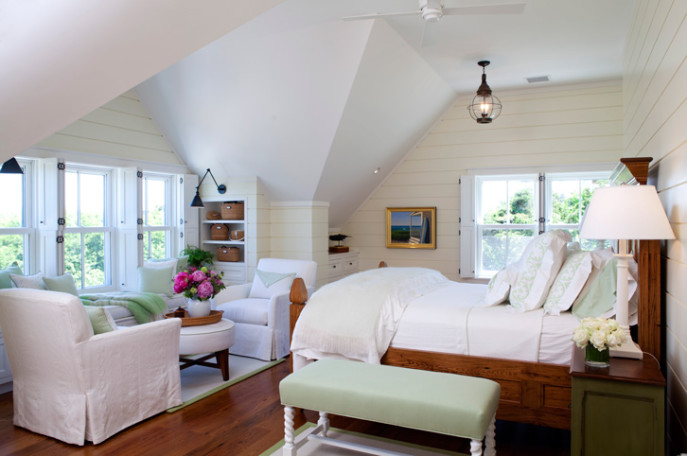
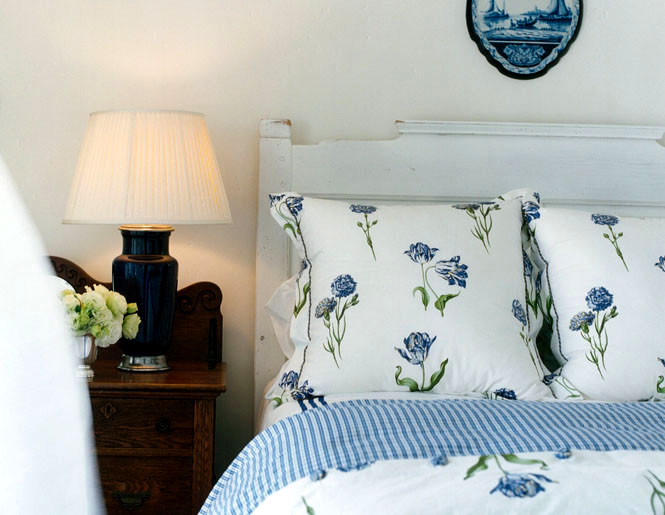
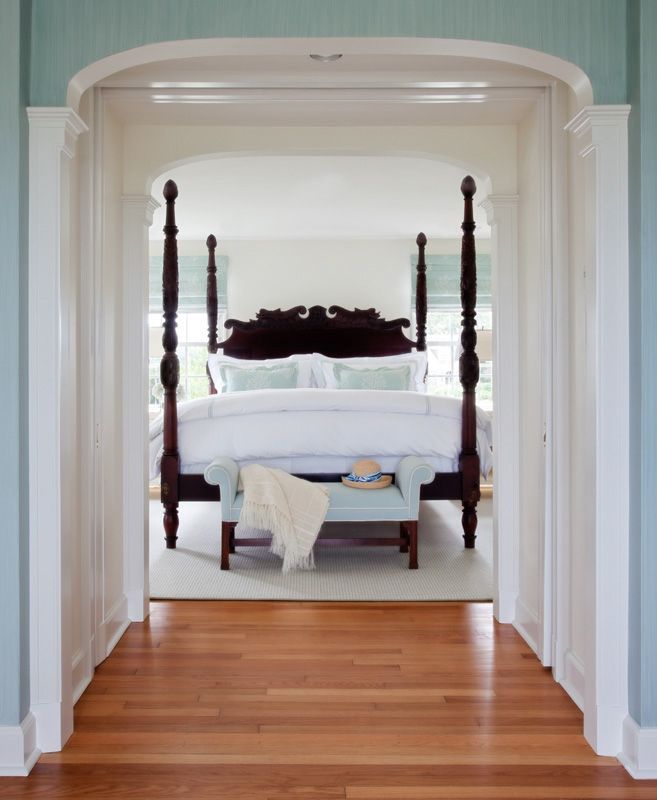
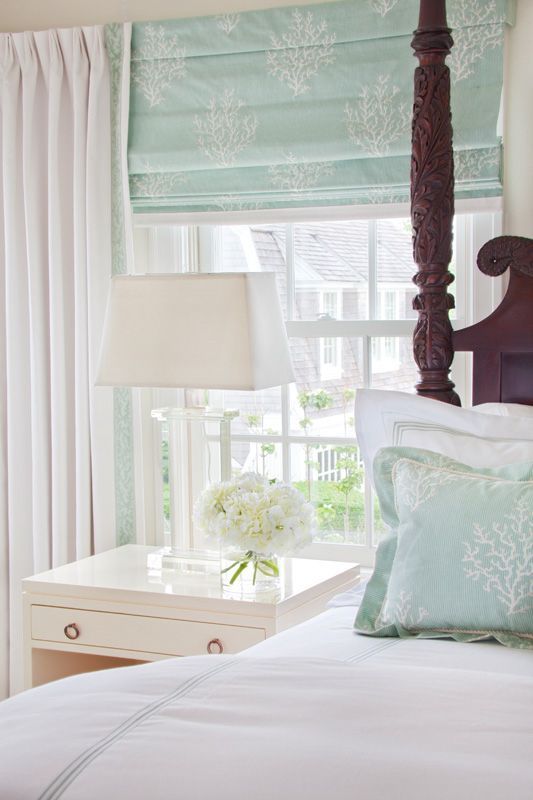
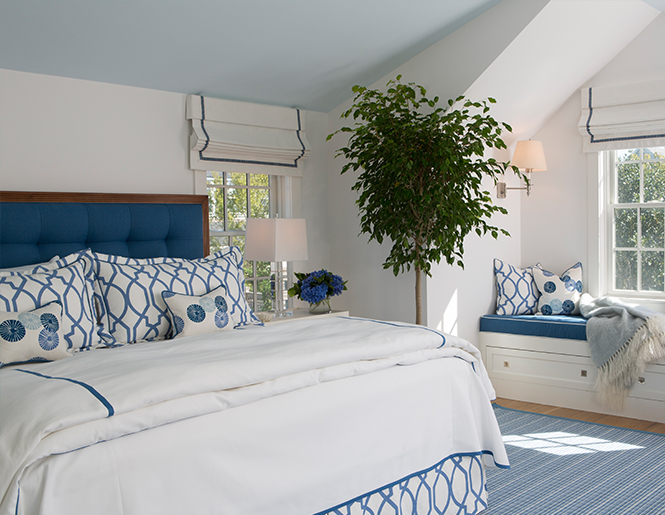

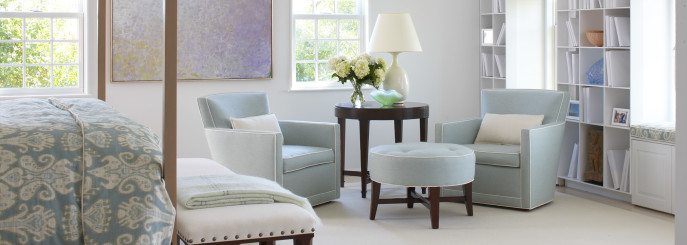
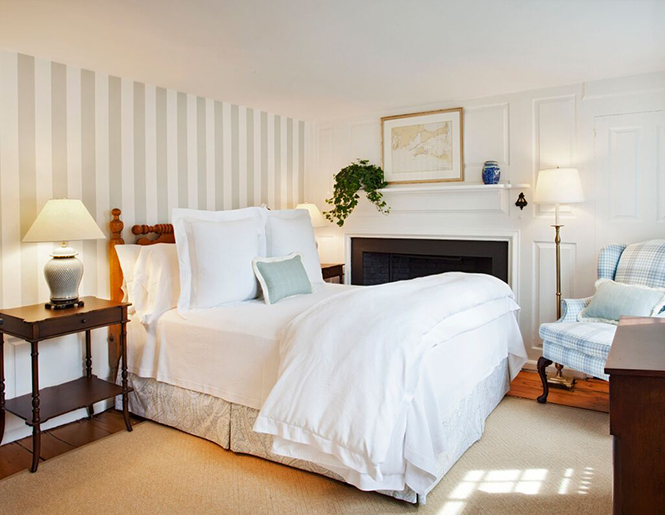
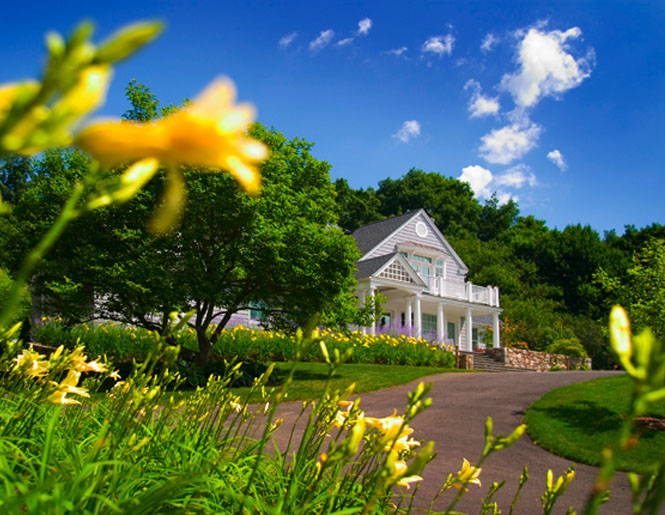
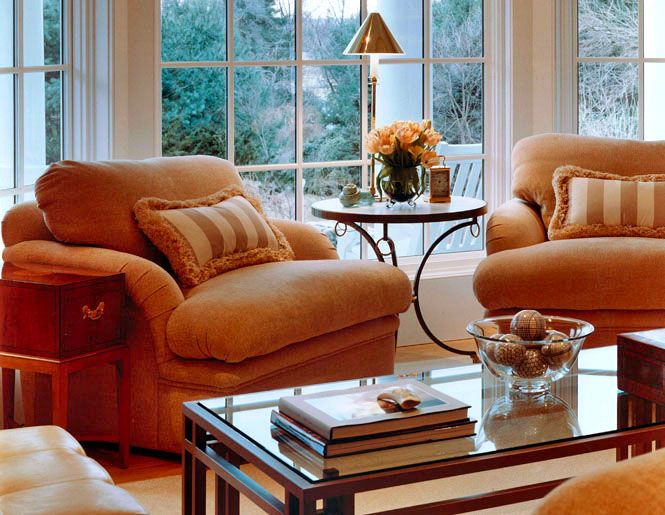
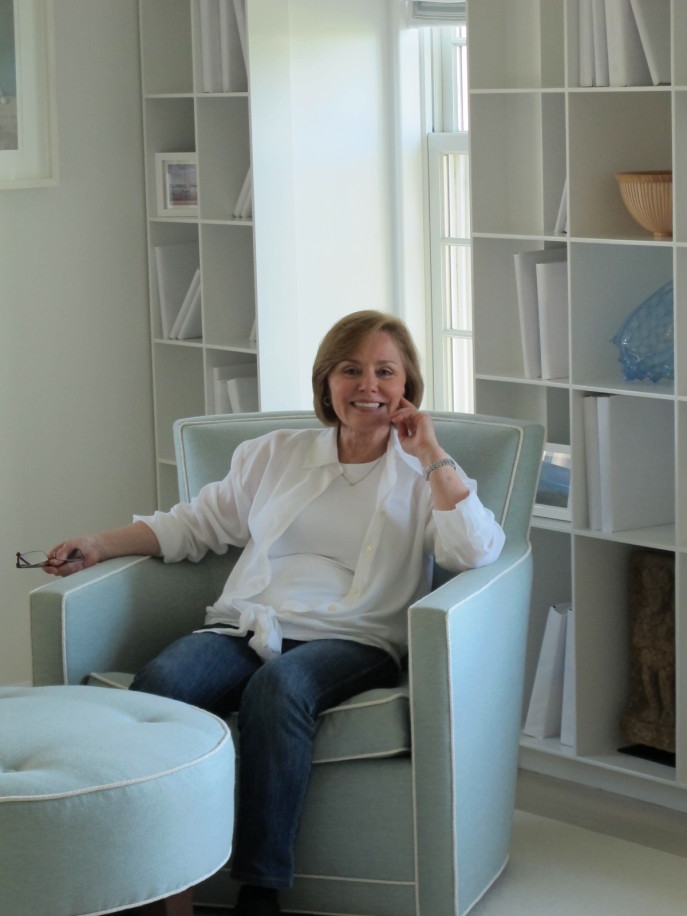


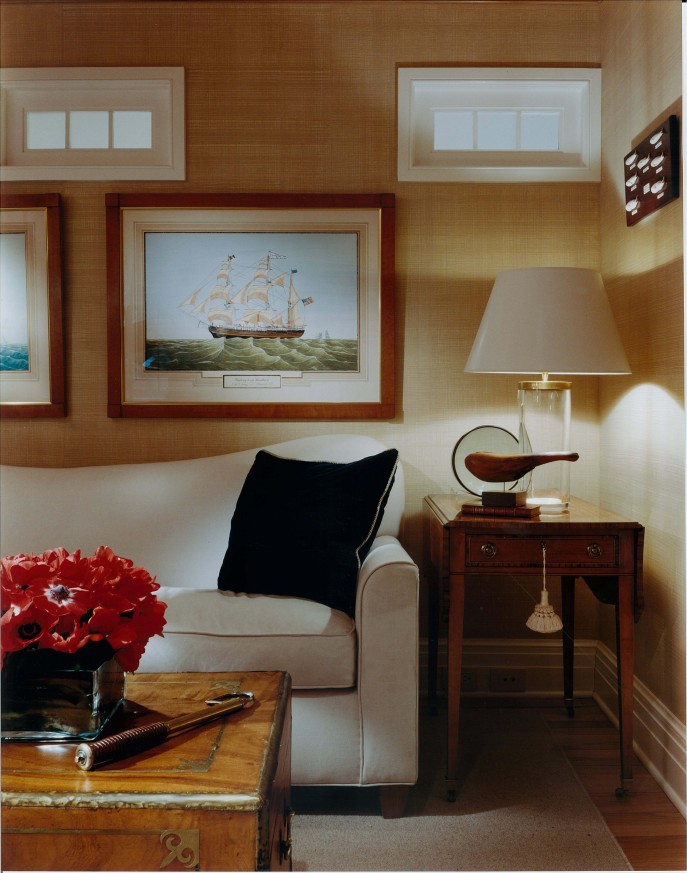
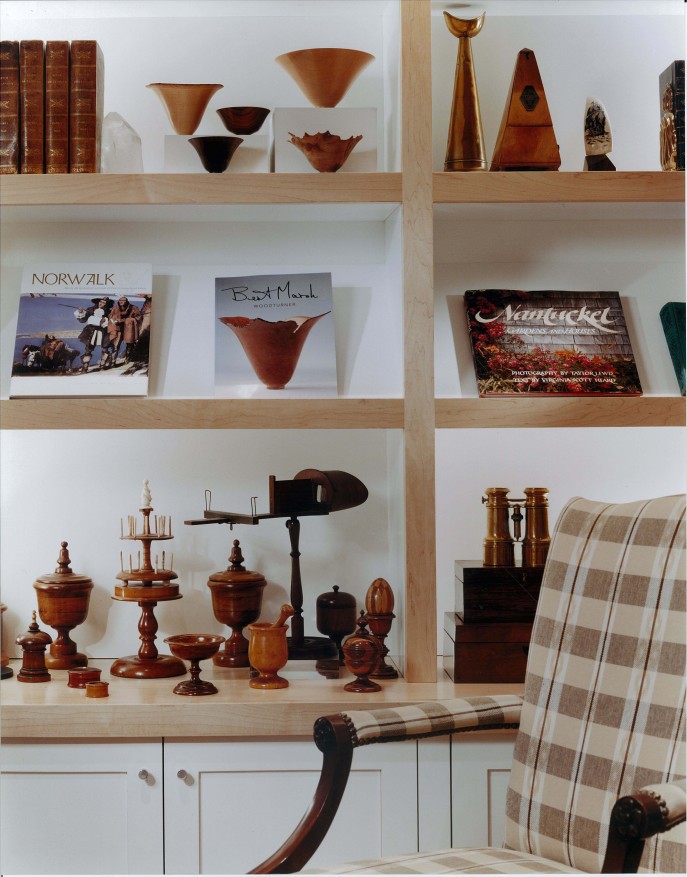
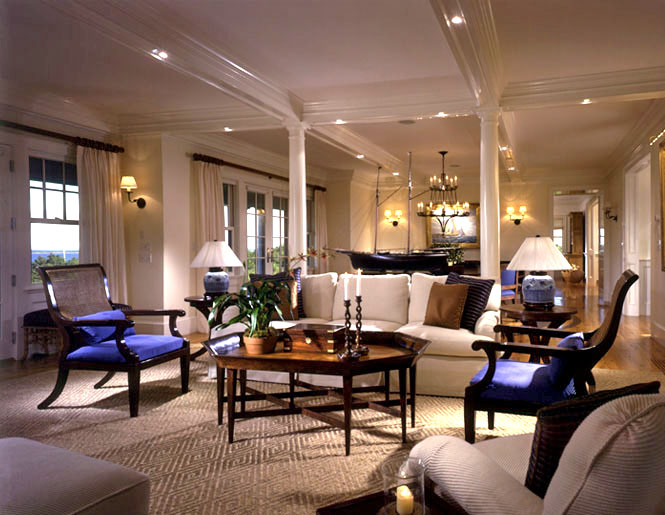

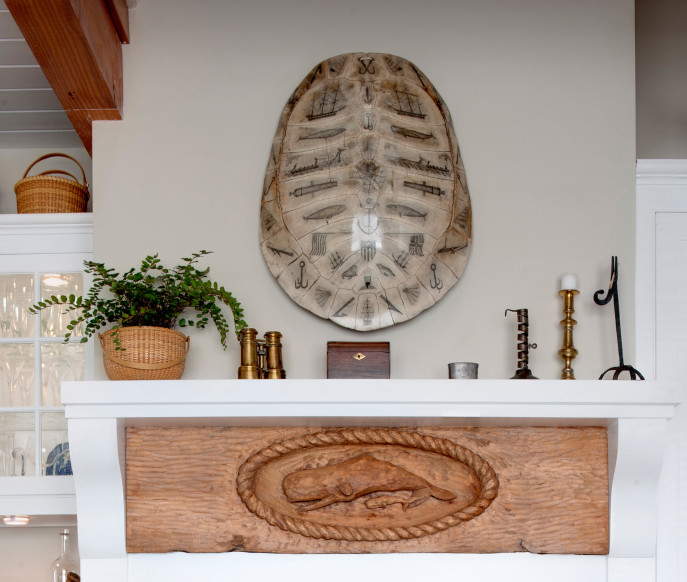

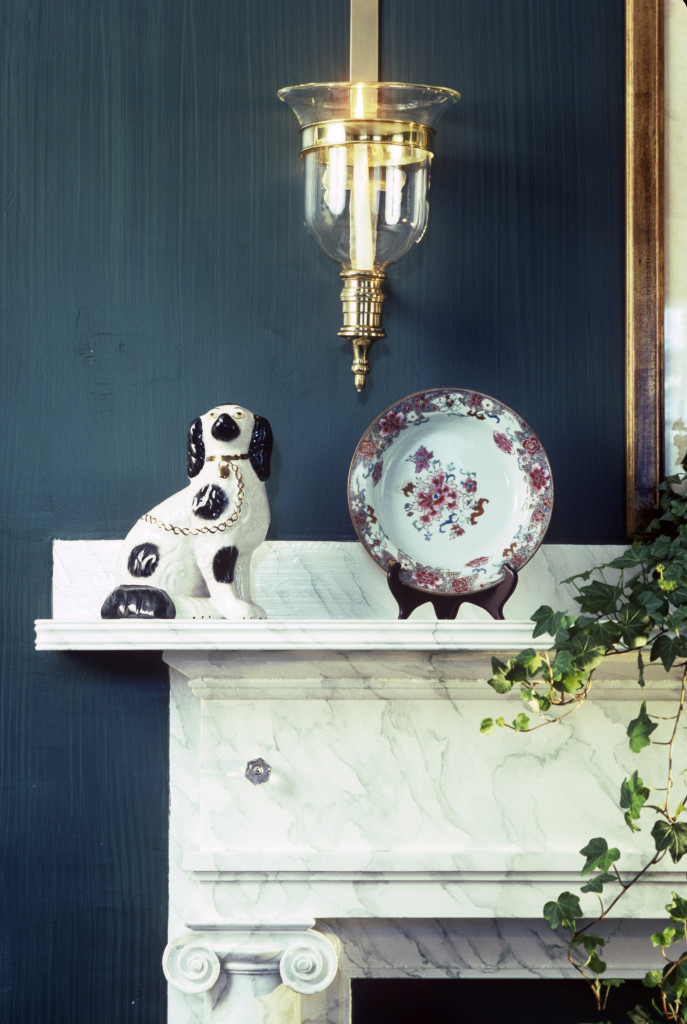
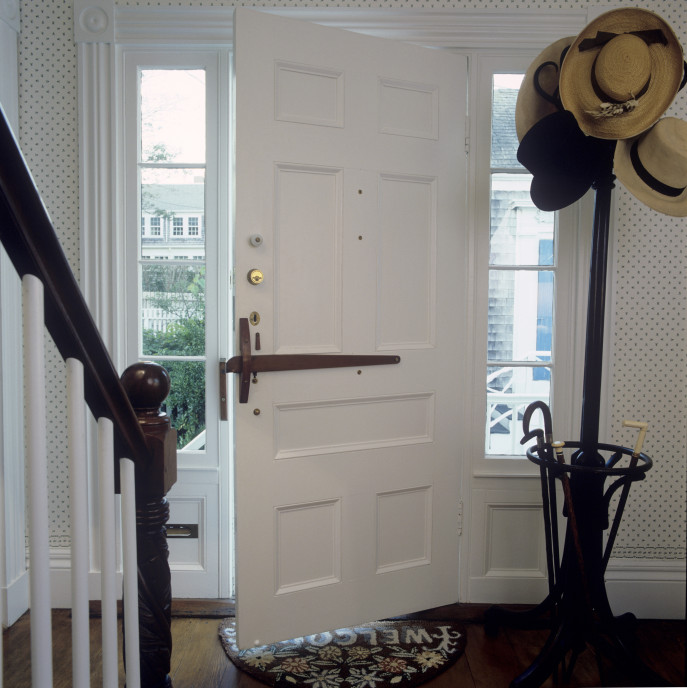
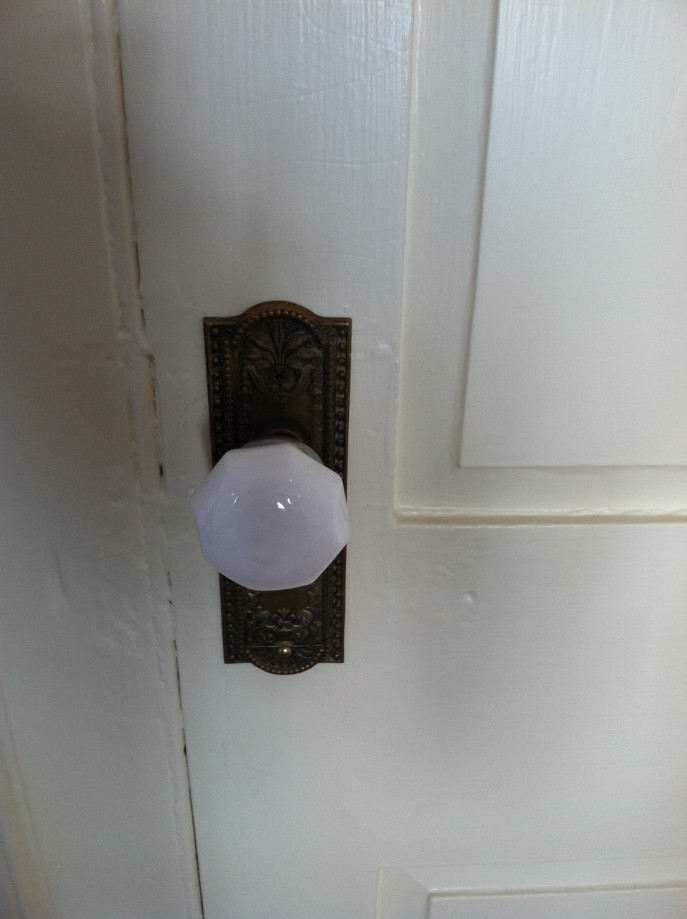
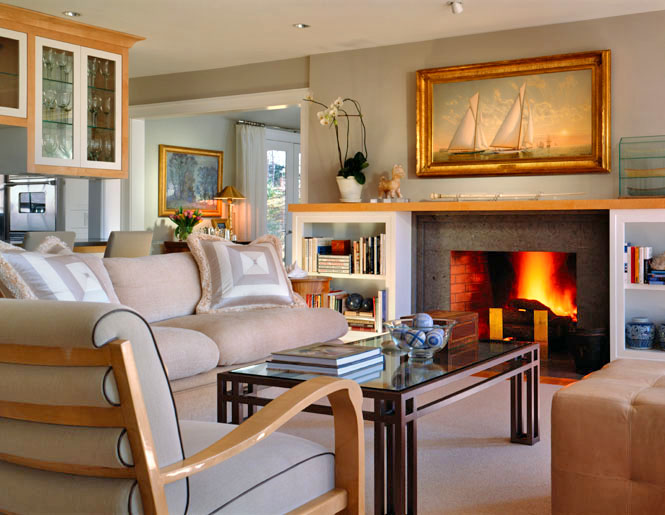
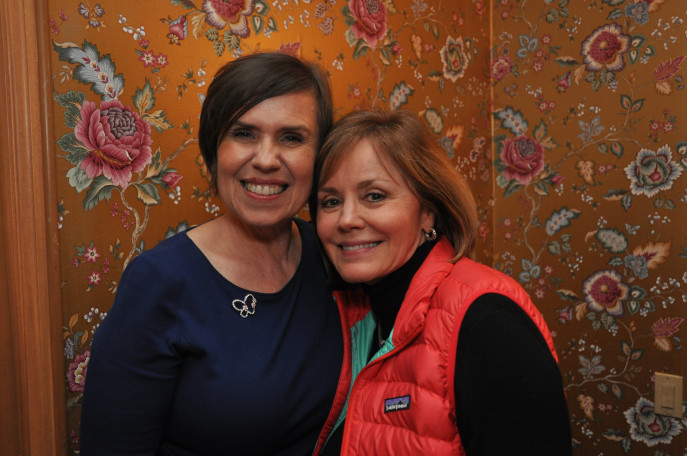
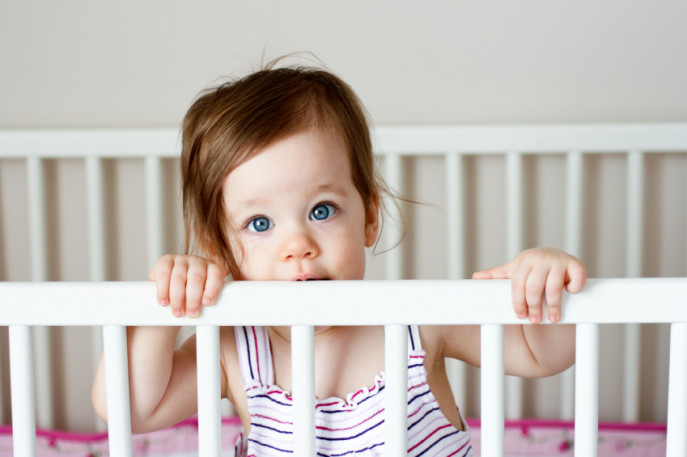


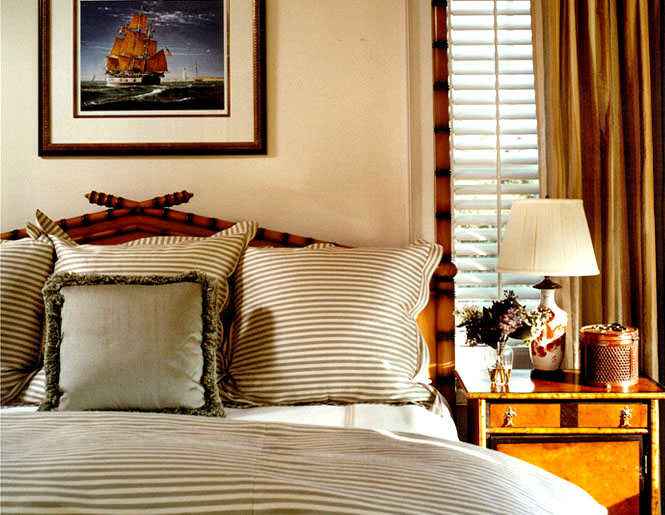
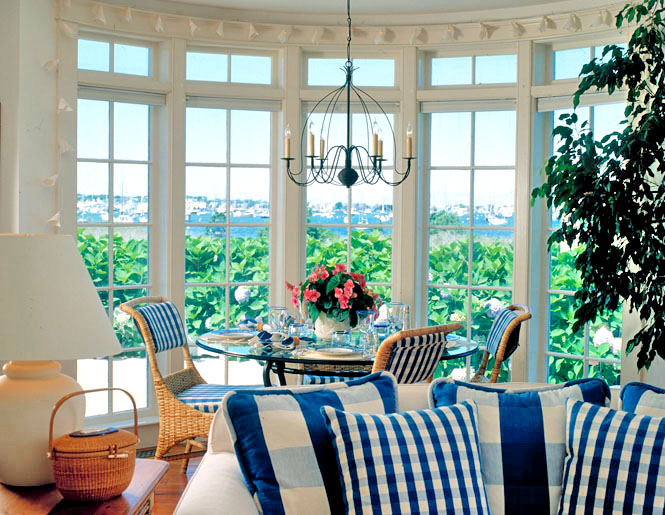

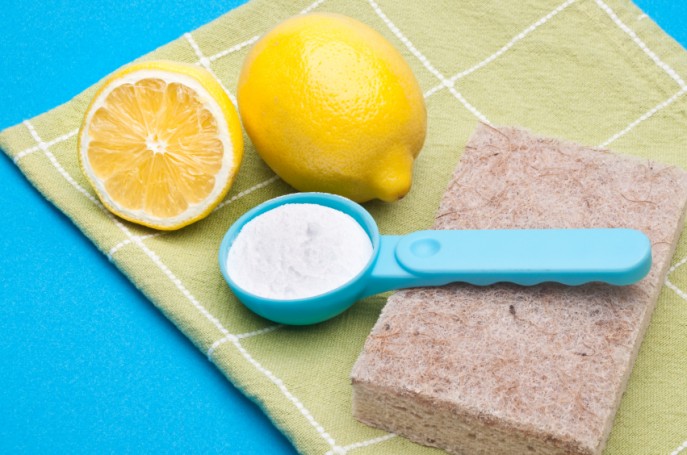

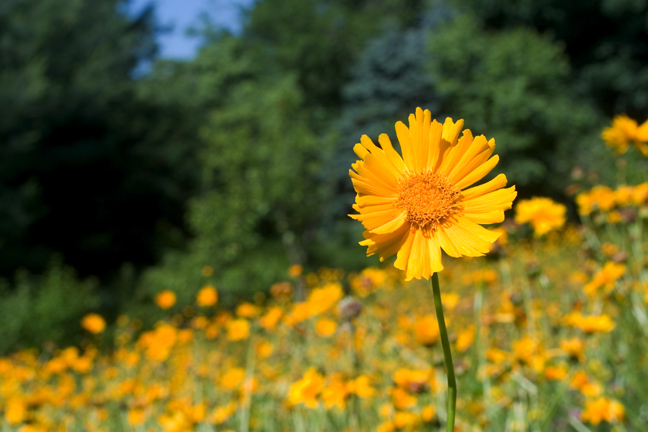

 Because my beach house is on Nantucket, it’s that island’s unique slant of light (rivaling Giverny) that I draw upon for inspiration in my design work. In decorating no two projects are alike. They’re client-driven, personal and unique. But there’s a reason for my love of blue and white (Chinese Export Porcelain) with touches of pink (New Dawn roses) and yellow (daffodils dancing down Milestone Road on the island.) There’s a reason for my love of sand and sea colors: to forget the shades of water and sky is impossible when your home is nestled somewhere near a beach.
Because my beach house is on Nantucket, it’s that island’s unique slant of light (rivaling Giverny) that I draw upon for inspiration in my design work. In decorating no two projects are alike. They’re client-driven, personal and unique. But there’s a reason for my love of blue and white (Chinese Export Porcelain) with touches of pink (New Dawn roses) and yellow (daffodils dancing down Milestone Road on the island.) There’s a reason for my love of sand and sea colors: to forget the shades of water and sky is impossible when your home is nestled somewhere near a beach.